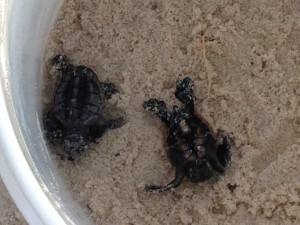Alabama’s Gulf Shore is home to several species of endangered sea turtles. While these animals spend most of their time living in the ocean, every year they return to Alabama to nest. When they return, they are, at youngest, 10 years old, and haven’t been back to the beach since they hatched. Still, they remember where to go.
There are three common species of sea turtles on Alabama’s beaches. Green sea turtles are globetrotters, with their ocean habitats extending through the Atlantic, Pacific, and Indian Oceans. Green sea turtles have been designated a threatened species since 1970. Their meat and eggs have long been a source of food for people, and international trade of these threatened animals is now against the law. Still, local hunting persists. In the past, these turtles were accidentally caught and killed by shrimp fishing boats. Many shrimp boats today take precautions against this.
 The loggerhead sea turtle is also categorized as threatened. These turtles are characterized by their large heads, and can grow to be up to 500 pounds. Like the green sea turtle, loggerheads have long been sought for their meat and eggs. Their winter behavior of staying in shallow waters puts them in danger of being accidentally caught and killed by fishing boats.
The loggerhead sea turtle is also categorized as threatened. These turtles are characterized by their large heads, and can grow to be up to 500 pounds. Like the green sea turtle, loggerheads have long been sought for their meat and eggs. Their winter behavior of staying in shallow waters puts them in danger of being accidentally caught and killed by fishing boats.
The Kemps Ridley turtle is the most at risk of all Alabama’s nesting sea turtles, having been categorized as endangered since 1970. They are smaller than the other threatened species of sea turtle, growing to be no more than 100 pounds at most. Many invasive animals also use their eggs as a food source, threatening their ability to reproduce. These turtles, like many sea animals, have also been known to die from eating floating refuse in the ocean, mistaking it for food.
From May to October, these three species of turtles come to the Gulf Shores beach in Alabama to lay their eggs. Depending on the species, the eggs take around 60 days to hatch. The mother turtles don’t stay to protect them, making these eggs and hatchlings vulnerable to both human and animal predation.
There are numerous programs in place to help protect these animals. Residents of the Gulf Shores area every year take steps to protect the nesting turtles and their eggs, so the animals can continue to live on in an increasingly hostile world. If you’re looking to move to the area, you too can be a part of these rescue efforts.



Leave a Reply